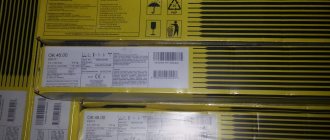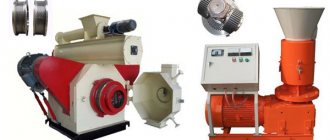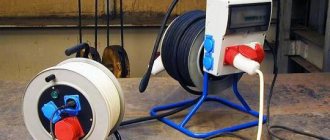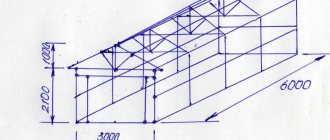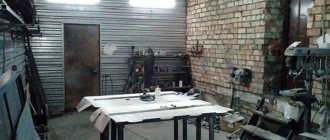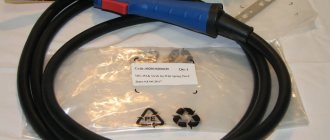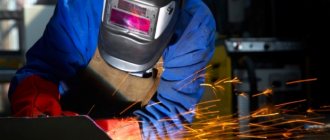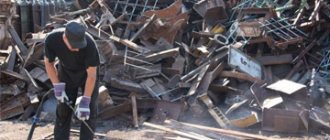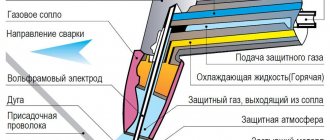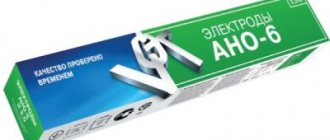Welding slags, their physical and chemical characteristics and properties.
What are welding slags, their physical and chemical characteristics and properties.
Slag is a melt of non-metallic compounds, namely oxides, halides, sulfides, salts, both free and forming complex compounds.
Most welding slags are insoluble in Me. In the molten state, Me and slag are immiscible liquids that differ in specific gravity (density).
The properties of slags and the nature of their interaction on Me are determined by their chemical composition. The composition affects the following physical properties: melting point, viscosity, the nature of the change in viscosity with temperature, density and interfacial tension.
There are two theories describing the structure of liquid slags: molecular and ionic.
According to molecular theory
slags are systems of free and chemically bonded non-metallic compounds, between which there is a mobile chemical equilibrium. In this case, only free compounds (for example, oxides) interact with Me. The presence of ions in slags is not denied by molecular theory, but their influence is neglected in the general interaction scheme.
According to ion theory
slags have an ionic structure, i.e. each cation (+) is surrounded by anions (-). Anions, in turn, are cations. The ionic structure of molten slag confirms their electrical conductivity and the improvement of electrical conductivity with increasing temperature. The chemical effect of molten slag on Me is largely determined by the ratio of basic, acidic and amphoteric oxides in its composition.
The main oxides are: K2O, Na2O, CaO, MgO, MnO, FeO, NiO.
Formally, the predominance of acidic or basic characteristics of the slag is assessed by the acidity coefficient Kk or the basicity coefficient Ko = 1/Kk.
Calculation of the acidity or basicity coefficient provides only an approximate assessment of the acidic or basic properties of the slag. For example, it is believed that if Kk > 1, then the slag is acidic, if Kk
where a,b,c,d are coefficients that take into account the different affinity of the main oxides for SiO2 (no more than 1).
If the flux contains SiO2 from 2 to 48%, CaO, MgO, MnO in small quantities, from 2 to 48% CaF2 (fluorite), then a = 1, b = 0.5, c = 0.37, d = 0, 26.
Amphoteric oxides can act as basic oxides under various conditions. In this case, complex compounds with acidic oxides are formed. This behavior occurs when the amount of basic oxides is insufficient. If there is an excess of basic oxides in the slag, then they behave as acidic.
Chemical exposure.
The effect of slag on Me can be either oxidizing or deoxidizing, in which case the slag is converted into oxides soluble in Me. Slags can change the content of sulfur and phosphorus in Me. The processes of interaction between slag and Me are influenced by the physical properties of slag. A very important characteristic is the melting point. The melting point of slag is a less certain characteristic, because slags change their viscosity over a wide temperature range. Depending on the nature of the change in viscosity with temperature, there are long and short slags. Short slags are the main ones. They harden in a small temperature range and, upon cooling, quickly transition from a state of significant fluidity to the formation of a slag crust.
Acidic slags gradually change their viscosity. After hardening they have an amorphous, glassy structure.
In real welding processes, slags must have a melting (solidification) temperature slightly different from the melting temperature of the welded Me.
If the melting point of the slag is much lower than the melting point of Me, then it will spread strongly over the heated edges being welded and will poorly protect the weld pool. At a very high melting temperature, the slag collects in the hottest zone, and the edges of the bath are exposed. The most favorable ratio is when the slag melts at a temperature slightly lower than the melting point of Me (when welding steels, this difference should be 200-300°C). There are cases when it is possible to use slags with a melting point higher than that of the welded Me (for example, welding Cu with OSTS-45 flux).
Viscosity of slag.
The viscosity of slag at the melting temperature of Me is always significantly greater than the viscosity of Me. However, this difference should not be very large. When welding steels hMe = 0.01-0.02 Poise (Metal melting temperature Tmel Me » 1500°C). Slags for welding such materials must have hshl £ 10 Poise. Slags with hsl > 10 Poise are not applicable. Because The high viscosity of slags for welding is undesirable; “fluxes” are added to them: fluorspar and rutile. These additives impart other properties to the slag.
All about welding slag
During the welding process, the working area at the junction of two metal parts comes into contact with environmental elements: oxygen, a mixture of protective gases, and molten slag. Such contact interaction occurs at high temperature conditions of metal melting. In some cases, such interaction may be positive for the metal, but to a greater extent gases, oxygen and slags change the chemical composition of the metal and its physical properties. For this reason, all processes of such interaction during welding work must be taken into account and the process must be purposefully regulated, directing it in the right direction.
Residues and cinders of steel welding electrodes / 91910001205 – online ecology
Production: Maintenance of machinery and equipment Process: Welding work
f – according to FKKO-2002 (2003); p – Criterion (1): degree of hazard of waste to the environment (calculation method for assigning to hazard class); e - Criterion (2): dilution factor of the aqueous extract from the waste, at which there is no harmful effect on aquatic organisms (experimental method for assigning to a hazard class); p, e – Criterion (1) and Criterion (2) (calculated and experimental method of assignment to hazard class); r, clause 4 – Criterion (1), with classification to the 4th hazard class in the absence of confirmation of the 5th hazard class using Criterion (2), according to clause 17 of the Order of the Ministry of Natural Resources of the Russian Federation dated December 4, 2020 No. 536.
What is it and how does it appear?
During welding, many by-products called slag are formed in the area where two metal parts meet. Welding slag looks like a black crust of loose density and heterogeneous structure. The reason for its appearance is natural, since slag is a welding by-product that appears on the weld seam. The composition of the waste includes melted flux elements or coating components of welding electrodes, as well as metal oxides. A by-product of the welding process, formed during the joining of metal parts and during the process of melting the electrode, fills the melting pool of the seam.
A by-product occurs in any type of welding work, and its most important functions are:
The welding by-product does not contain pure metal; on the contrary, the slag consists of its oxides formed during the melting of metal and flux. A typical set of welding by-product elements consists of iron oxide, manganese and titanium oxides, silicon and calcium oxides. In addition, electrode coating elements are added to this set, which slightly change the existing picture.
Sale of welding waste
The size of the cinders depends directly on the welder, more precisely on the place where he finished the work and is 50 - 100 mm. Thus, electrode waste remains a promising market for scrap metal. However, you should differentiate between web ads. Often, the phrase: let's buy the remains of electrodes means illiquid goods, and not a steel cinder, as such.
Disposal of welding waste, especially electrode residues, is becoming a regulated procedure. As a result, steel cinders are collected directly at the welding site and sorted according to the brand of the product. Next, the scrap metal is weighed and can be sold to a recycling site.
Alternatively, you can sell welding slag. The price for this type of waste will be significantly lower, and it is more difficult to find a buyer for it.
How to distinguish from metal when welding?
The process of slag formation must be constantly monitored during welding. This is necessary so as not to miss the moment of slag leaking and clogging the welding seam. To control the process, you need to know how to distinguish between hot metal and slag during welding. The characteristic differences are as follows:
The differences that exist between molten metal and welding by-products are based on the density and fluidity of the metals. Metal and slag have different heating rates. When the welding process begins, the metal heats up, melts and at the same time acquires a bright red color. After the welding process is completed, the seam gradually cools and acquires a dark tint, while the slag rises to the surface of the seam. The slag starts out dark in color, but as it cools it becomes lighter in color than the metal.
If you clean the seam by tapping it with a hammer and filing it, you can easily distinguish between the pronounced shine of the metal and the dark matte inclusions of slag.
Steel cinders, other waste from the welding process
It is easy to determine the specific type of slag by knowing the composition of the electrodes: their coating, as well as the flux, if used. On the other hand, it is another type of arc welding waste. It is defined by FKKO as residues and cinders of steel welding electrodes.
This type of product is the main consumable material of the welding process. Despite the relatively small size of the waste: a part of the rod remains from the electrode, fixed in the holder fork; the total mass of cinders is quite large. In some industries it amounts to hundreds of kilograms of scrap metal.
Remains of welding electrodes
Indeed, most electrode cinders no longer have a coating and are ordinary metal wire of a certain diameter. In this case, the density of residues and cinders of steel welding electrodes is equivalent to a similar parameter of the metal. Thus, such waste can be melted down to produce new consumables.
Of course, the composition of welding electrode residues remains an important characteristic. Therefore, it is necessary to sort the cinders according to their type in order to obtain steel during the remelting process that is already alloyed with the required chemical composition and does not require further purification.
Why and how to delete?
Immediately after the welding process is completed, metal oxides protect the weld from excessively rapid cooling. For the strength of the weld, it is important that the metal cools slowly and evenly. But after the seam has cooled, the slag must be removed. This is done not only to check the strength of the seam for the presence of defects, which appear in the form of so-called tops and inclusions of a non-metallic structure, but also to ensure an even and beautiful joint.
After completing the welding work, the finished seam needs to be cleaned; it is especially important to do this when connecting parts of greater thickness, and to ensure the reliability of the joint, several welding seams are made on top of the previous ones. If welding by-products are not removed, it will be impossible to make the next weld, since the slag will extinguish the welding arc. If the welding slag has high viscosity, it must be removed, otherwise the weld will form inconsistently and chaotically, forming a crust and defects. In such a weld, the temperature drops evenly when slag is removed after welding, and this makes it possible to form an even joint. If you slow down the decrease in temperature of the finished weld, the welding by-product will come to the joint surface and easily separate. To ensure this possibility, alloy steel parts are heated before the welding process to a temperature of 200° to 400°.
Welding slag has a porous structure and forms weak bonds with the metal; it is removed by mechanically treating the surface of the finished weld. Welding waste in molten form causes the weld to be weak and quickly collapse. You can get rid of slag and its penetration into the weld if you change the mode of the welding process, as well as with the correct position of the electrode relative to the position of the parts being joined. The slag is removed immediately after the metal seam has cooled and turned black.
In addition to adding slag to alloys, they can also be included in small quantities in fluxes.
Watch all about welding slag in the following video.
Specific gravity of construction waste in 1 m3
Any repair or construction work cannot be done without waste. And in order to know which and how many vehicles to order for removal, and of course calculate the cost, you need to know the specific gravity of construction waste. As a rule, in the end it is converted from cubes to weight (tons), which makes it much easier to calculate.
Demolition or construction is always a huge pile of waste. It is always included in the budget for any work. To save time and money, you need to promptly convert cubes of garbage into tons. You can do this yourself, or contact a specialist. In this article we will just talk about the second option.
Construction waste weight 1 m3
You need to understand that different types of waste have their own density. For example, the density of wooden debris will be much lower than that of concrete. Let's say, if you take two garbage containers and fill them, the container with concrete will be heavier. Knowing the density of construction waste is very important, because it will let you know how many trucks you need to order for removal, as well as the cost of the work done.
Below are the averaged values of waste density in m3:
The above data refers to buildings “in a dense body,” that is, not disassembled. The actual density of disassembled structures will differ (t/m3):
Weight of construction waste in 1 m3 table
Below are data on the volume and specific gravity of construction waste.
2,50
| Garbage type | Package | Volumetric weight, tons/m3 | Specific gravity, m3/ton | ||
| Oscillation limits | Average calculated value | Oscillation limits | Average calculated value | ||
| Construction waste | in bulk | 1,10 – 1,40 | 1,20 | 0,91 – 0,71 | 0,83 |
| Household and street garbage | in bulk | 0,30 – 0,65 | 0,55 | 3,33 – 1,54 | 1,82 |
| Wooden scraps | in bulk | 0,35 – 0,55 | 0,40 | 2,86 – 1,82 | 2,86 – 1,82 |
| Fabric scraps | in bulk | 0,30 – 0,37 | 0,35 | 3,33 – 2,70 | 2,86 |
| Wood sawdust | in bulk | 0,20 – 0,30 | 0,25 | 5,00 – 3,33 | 4,00 |
| Snow wet | in bulk | 0,70 – 0,92 | 0,80 | 1,43 – 1,09 | 1,25 |
| Snow wet | in bulk | 0,40 – 0,55 | 0,45 | 2,50 – 1,82 | 2,22 |
| Snow is dry | in bulk | 0,10 – 0,16 | 0,12 | 10,00 – 6,25 | 8,33 |
| Boiler slag | in bulk | 0,70 – 1,00 | 0,75 | 1,43 – 1,00 | 1,33 |
| Crushed brick | in bulk | 1,20 – 1,35 | 1,27 | 0,83 – 0,74 | 0,79 |
| Wood chips | in bulk | 0,15 – 0,30 | 0,25 | 6,68 – 3,33 | 4,00 |
| Electrical fittings | in bulk | 0,37 – 0,63 | 0,50 | 2,70 – 1,59 | 2,00 |
| Asphalt, bitumen, crushed tar | in bulk | 1,15 – 1,50 | 1,30 | 0,87 – 0,67 | 0,77 |
| Various fights, glass, faience | in bulk | 2,00 – 2,80 | 0,50 – 0,36 | 0,40 | |
| Paper | rolls | 0,40 – 0,55 | 0,50 | 2,50 – 1,82 | 2,00 |
| Paper | bales | 0,65 – 0,77 | 0,70 | 1,54 – 1,30 | 1,43 |
| Paper | ligaments | 0,50 – 0,65 | 0,55 | 2,00 – 1,54 | 1,82 |
| Old pressed paper - waste paper | bales | 0,35 – 0,60 | 0,53 | 2,86 – 1,67 | 1,89 |
| Bottles are empty | in bulk | 0,35 – 0,42 | 0,40 | 2,86 – 2,38 | 2,50 |
| Rags | bales | 0,15 – 0,20 | 0,18 | 6,68 – 5,00 | 5,56 |
| Large metal products, pipe parts | 0,40 – 0,70 | 0,60 | 2,50 – 1,43 | 1,67 | |
| Plastic products | without packaging | 0,40 – 0,65 | 0,50 | 2,50 – 1,54 | 2,00 |
| Glass products other than sheet glass | 0,26 – 0,50 | 0,40 | 3,85 – 2,00 | 3,85 – 2,00 | |
| Cardboard | bales | 0,59 – 1,00 | 0,70 | 1,70 – 1,00 | 1,43 |
| Cardboard | ligaments | 0,42 – 0,45 | 0,43 | 2,38 – 2,22 | 2,33 |
| Scrap steel, cast iron, copper and brass | in bulk | 2,00 – 2,50 | 2,10 | 0,50 – 0,40 | 0,48 |
| Aluminum scrap | in bulk | 0,60 – 0,75 | 0,70 | 1,67 – 1,33 | 1,43 |
| Oversized household scrap | in bulk | 0,30 – 0,45 | 0,40 | 3,33 – 2,22 | 2,50 |
| Various small machine parts | in bulk | 0,42 – 0,70 | 0,50 | 2,38 — 1,43 | 2,00 |
| Various furniture | 0,25 – 0,40 | 0,30 | 4,00 – 2,50 | 3,33 | |
Having the above garbage weight table at hand, you can easily convert cubes (m3) into tons. In this way, you can save a significant portion of the money that you would end up paying for work that you yourself are able to do.
Weight of construction waste in 1 m3 - table
When carrying out repair work, a person is always puzzled by the question of where to put the construction waste. Often you can’t carry it in bags. You have to order movers and a car. To save on transport, you need to calculate how many cubic meters of waste need to be removed. A table with indicators for each type of material will help you correctly determine the weight of construction waste in 1 m3. With its help you can calculate weight by volume and vice versa.
Density of construction waste
Garbage is different from garbage. If you take the same volume of concrete and wood, their weight will be completely different. Therefore, when planning a large cleaning, you need to know the specific gravity of construction waste in 1m3. Naturally, concrete will be much heavier than wood.
The density of materials is a very important indicator. It is he who displays the specific gravity of construction waste in 1 m3. By calculating the mass of waste through its density, you can easily determine the cubic capacity of the cars that need to be ordered. And, of course, the cost of the service provided depends on this.
We present average indicators that measure the weight and volume of materials. Data are presented in tons per 1 m 3:
All of the above data relates to materials that consist of large debris or old structures. If we talk about disassembled and small parts, then the weight/cube is different:
Weight to volume ratio
You can determine the volumetric weight of construction waste for estimates, as well as for calculations at the household level, using the table presented below.
| Waste | Collection method | Volumetric weight, kg/m 3 | Specific weight, kg/t |
| Construction materials waste | in bulk | 1200 | 0,83 |
| Household garbage | in bulk | 550 | 1,82 |
| Edged wood waste | in bulk | 400 | 2,86 – 1,82 |
| Scraps of fabric | in bulk | 350 | 2,86 |
| Wood sawdust | in bulk | 250 | 4 |
| Wet snow | in bulk | 800 | 1,25 |
| Slightly wet snow | in bulk | 450 | 2,22 |
| Dry snow | in bulk | 120 | 8,33 |
| Boiler room slag | in bulk | 750 | 1,33 |
| Crushed brick | in bulk | 1270 | 0,79 |
| Wood chips | in bulk | 250 | 4 |
| Electric wires | in bulk | 500 | 2 |
| Bitumen waste, tar and asphalt | in bulk | 1300 | 0,77 |
| Glass and porcelain fight | in bulk | 2500 | 0,4 |
| Paper | in rolls | 500 | 2 |
| Paper | bale | 530 | 1,43 |
| Paper | bunch | 550 | 1,82 |
| Pressed paper | bale | 530 | 1.89 |
| Empty bottles | in bulk | 400 | 2,5 |
| Rags, rags | bale | 180 | 5,56 |
| Large parts of metal, pieces of pipes | 600 | 1,67 | |
| Plastic waste | without packaging | 500 | 2 |
| Waste of non-flat glass products | 400 | 3,85 – 2 | |
| Cardboard waste | bale | 700 | 1,43 |
| Cardboard | bunch | 430 | 2,33 |
| Metal fragments of steel, cast iron, copper and brass | in bulk | 2100 | 0,48 |
| Metal scraps from aluminum | in bulk | 700 | 1,43 |
| Oversized household metal waste | in bulk | 400 | 2,5 |
| Small automobile parts | in bulk | 500 | 2 |
| Miscellaneous furniture waste | 300 | 3,33 |
Calculation methods
Before you start dismantling a building, thoughts arise about where to put the garbage. There is only one solution - order pickup. Everyone wants to know in advance how much it will cost financially. To do this, first calculate how much waste can be generated from a building that has not yet been dismantled. Main stages:
Required amount of equipment
Having determined the weight of the garbage, we move on to the next stage - ordering equipment. If you correctly determine which car to order, you can seriously save money by avoiding unnecessary expenses. It is the volume of waste (not weight) and the type of recycled materials that need to be taken into account: containers are quite suitable for light waste. It includes bars, wood of any kind, logs.
Heavy waste requires closed bins. Concrete debris, broken bricks, and soil will go here after sorting.
Similar actions are carried out for the removal of heavy waste. When ordering dump trucks, you need to specify the volume that can be placed on the machine at one time, then you can easily calculate how many trips need to be made.
It would seem that such a frivolous issue as garbage requires a rather responsible approach. The main factor in solving problems with waste disposal is the ability to correctly determine its volume and weight.
A table of correspondence between these two values will come to the rescue. You can also use an online calculator, with which you can cope with the task much faster.
Features of metallurgical slag recycling
Ash processing makes it possible to produce products used in construction:
- slag pumice - used as a component of slag concrete;
- granular residues - used for the production of cinder blocks, Portland cement;
- mineral wool – sound and thermal insulation of pipes, ceilings, walls;
- crushed stone – used in road construction and concrete production.
For slag casting, blast furnace residues are used. Metal-slag pipes produced by this method significantly reduce metal consumption for pipe production.
From ferroalloy residues, which contain iron in large quantities, a reverse product can be obtained.
Granulated fuel slags are used in agriculture as fertilizer.
The PETROMAX company provides services for the collection and disposal of metallurgical waste in Moscow and the Moscow region.
